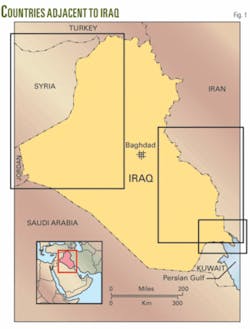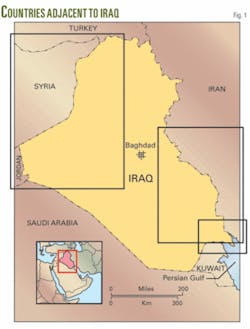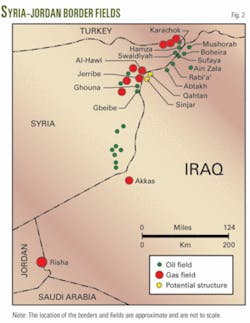A recent study advocates that the many fields that lie along Iraq’s borders should be operated jointly with the adjacent country (Fig. 1).
The Centre for Global Energy Studies (CGES) conducted the study in reaction to February 2008 claims in the Iraqi press that neighbouring countries were stealing Iraq’s oil.
These claims recall the assertions of Saddam Hussein’s regime in 1990 that Kuwait was stealing oil from Iraq’s South Rumaila field by excessive production from the Ratga field. This alleged theft was one of Saddam’s justifications for invading Kuwait.
Also in 2001, Iraq claimed Kuwait’s overproduction in the Ratga and Abdalli fields had led to about 50 million bbl moving into Kuwait from two Iraqi fields: South Rumaila and Safwan (part of the Zubair field complex).
Joint operations
The study suggested that an ideal approach is for two adjacent countries to undertake joint appraisal, planning, development, and production operations of fields on their common border, as well as for fields on either side of the border so that it can be verified that the fields are connected or are in separate reservoir systems.
Even for two separate fields, the study noted that a joint production system sharing some surface facilities might be preferable; however, technical and political expediency requires a high degree of cooperation and coordination.
The study further said that joint operations would benefit even border fields that were developed separately and produced for decades such as Naft Shahr-Naft Khaneh on the Iran-Iraq border, or Ratga-South Rumaila and Abdalli-Safwan-Zubair on the Kuwait-Iraq.
The CGES study reviewed and analyzed the oil and gas fields on or near the borders with Iran, Kuwait, Jordan, and Syria and suggested which field might continue across the borders.
Syria, Jordan borders
Fig. 2 shows the fields discussed in the study that are on Iraq’s border with Syria and Jordan.
On the Syrian side are:
- Al-Hawl, gas discovery that could extend into the Qahtan structure in Iraq.
- Gbeibe, oil discovery that was producing in the 1980s.
- Ghouna, oil discovery and gas tested.
- Hamza, producing oil field.
- Jerribe, gas discovery that could extend into Jabal Sinjar structure in Iraq.
- Karachok, producing oil field that was the first oil field discovered in Syria.
- Swaidiayh, producing oil field that extends into the Sufaya in Iraq.
Fields on the Iraqi side include:
- Abtakh, potential oil discovery.
- Boheira, unevaluated oil discovery.
- Mushorah, unevaluated oil discovery.
- Rabi’a’, potential oil discovery.
- Sufaya or Sfaiya, producing oil field.
- Jabal Sinjar, potential structure with gas.
- Qahtan, potential structure with gas.
On the Jordan border are:
- Risha, producing gas field on the Jordanian side that apparently extends into Iraq.
- Akkas, gas and oil discovery in Iraq’s Western Desert. The field is closer to the Syrian border but gas properties are similar to those in the Risha field.
Iran border
Straddling the Iran-Iraq border are Naft Shahr-Naft Khaneh fields, nearly depleted oil fields on production since the 1920s.
Fields on the Iranian side include:
- Azadegan, producing oil field that is possibly connected with Majnoon in Iraq.
- Danan, producing oil field.
- Dehluran, producing oil field that is possibly connected with Abu Ghrab in Iraq.
- Yadavaran, producing oil field.
- West Paydar, producing oil field.
Fields on the Iraqi side include:
- Abu Ghrab, producing oil field.
- Badra, low potential oil field that possibly extends into Iran.
- Huwaiza, oil field awaiting development.
- Jabal Fauqi, Fauqi, or Al-Fakkah, producing oil field.
- Majnoon, producing oil field.
- Siba, undeveloped oil field that possibly extends into Iran.
- Chah Surkh, undeveloped gas field.
- Jaria Pika, undeveloped gas field
Kuwait border
Fields on the Kuwaiti side include:
- Abdalli, producing oil field that is possibly an extension of Safwan in Iraq.
- East Abdalli, oil prospect that is possibly an extension of Umm Qasr in Iraq.
- Ratga, producing oil field that is an extension of South Rumaila in Iraq.
- Raudhatian, producing oil field.
- Sabriyah, producing oil field,
- West Abdalli, oil prospect.
Fields on the Iraqi side include:
- Jraishan, oil discovery.
- Rachi, producing oil field.
- South Rumaila, producing oil field.
- Safwan, producing oil field.
- Umm Qasr, producing oil field.




